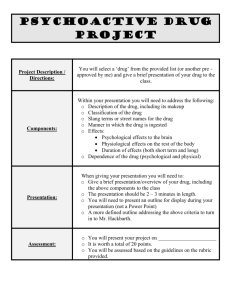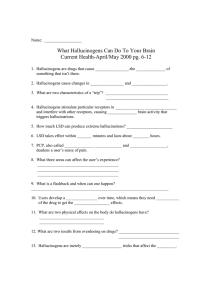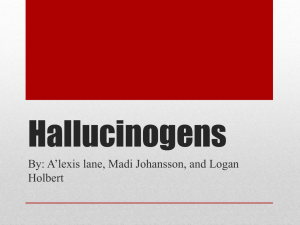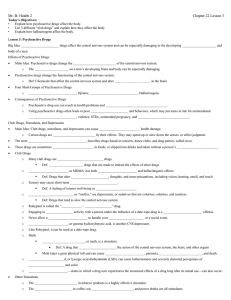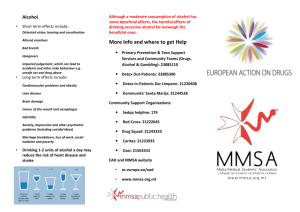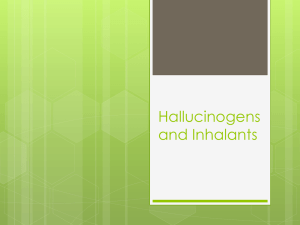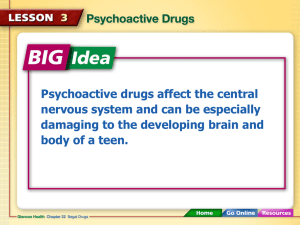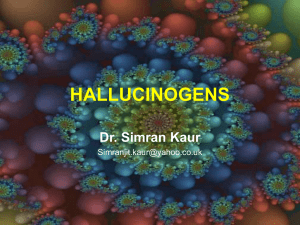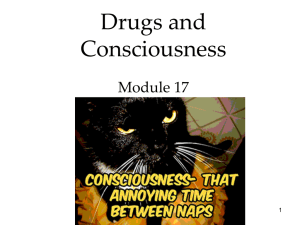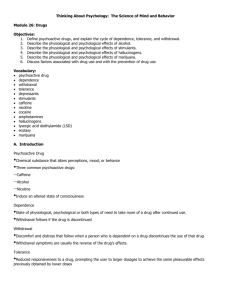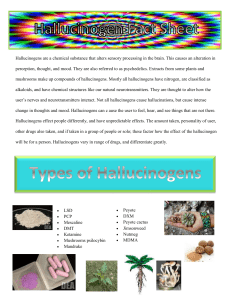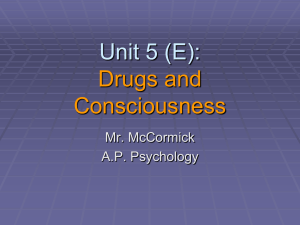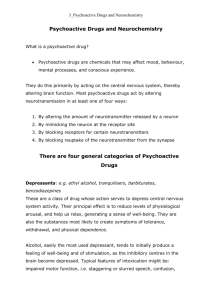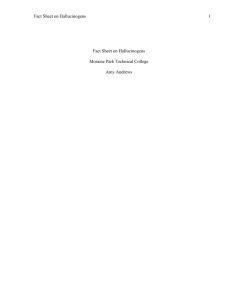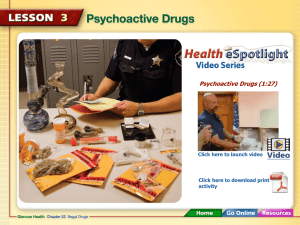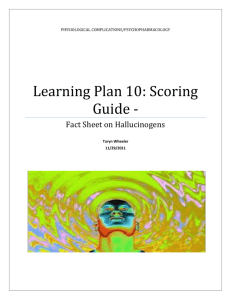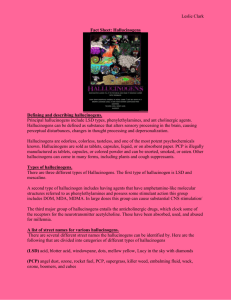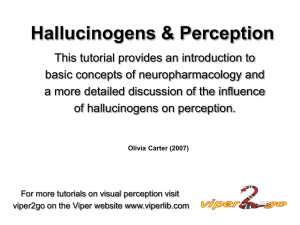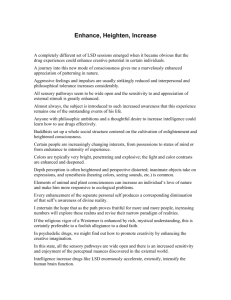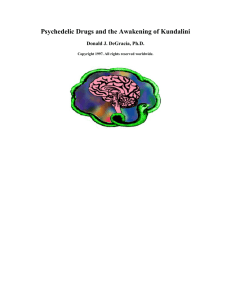Hallucinogens
advertisement
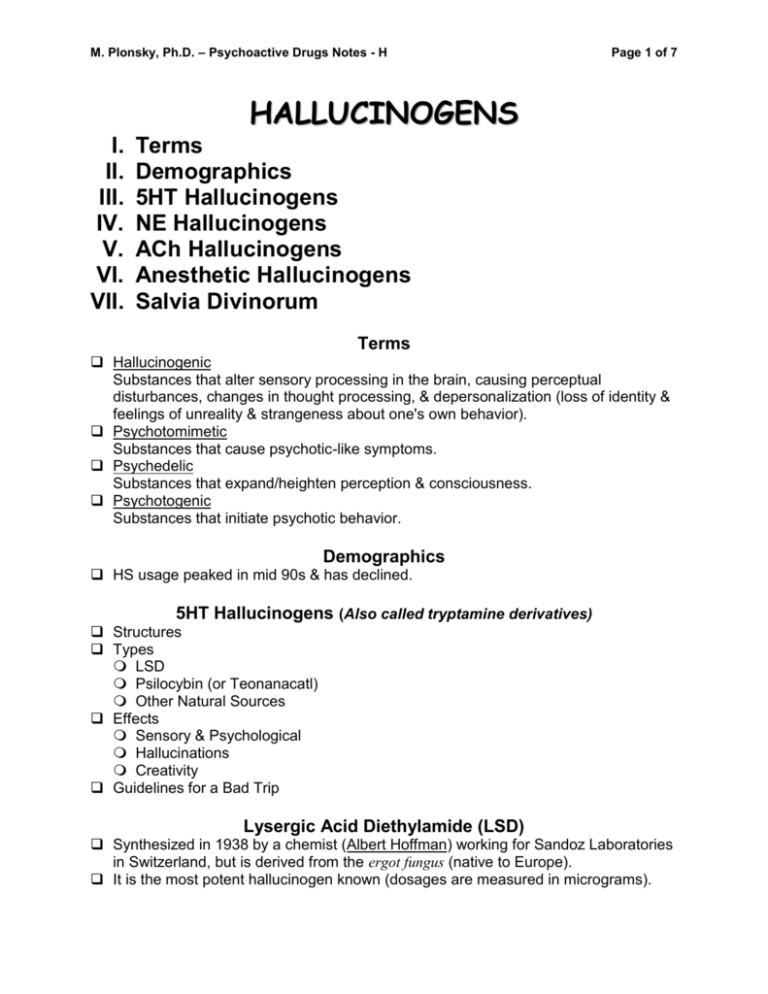
M. Plonsky, Ph.D. – Psychoactive Drugs Notes - H Page 1 of 7 HALLUCINOGENS I. II. III. IV. V. VI. VII. Terms Demographics 5HT Hallucinogens NE Hallucinogens ACh Hallucinogens Anesthetic Hallucinogens Salvia Divinorum Terms Hallucinogenic Substances that alter sensory processing in the brain, causing perceptual disturbances, changes in thought processing, & depersonalization (loss of identity & feelings of unreality & strangeness about one's own behavior). Psychotomimetic Substances that cause psychotic-like symptoms. Psychedelic Substances that expand/heighten perception & consciousness. Psychotogenic Substances that initiate psychotic behavior. Demographics HS usage peaked in mid 90s & has declined. 5HT Hallucinogens (Also called tryptamine derivatives) Structures Types LSD Psilocybin (or Teonanacatl) Other Natural Sources Effects Sensory & Psychological Hallucinations Creativity Guidelines for a Bad Trip Lysergic Acid Diethylamide (LSD) Synthesized in 1938 by a chemist (Albert Hoffman) working for Sandoz Laboratories in Switzerland, but is derived from the ergot fungus (native to Europe). It is the most potent hallucinogen known (dosages are measured in micrograms). M. Plonsky, Ph.D. – Psychoactive Drugs Notes - H Page 2 of 7 Compared to other hallucinogenic substances, LSD is 100x more potent than psilocybin & 4,000x more potent than mescaline. Forms Psilocybin Mushrooms of genus psilocybe, conocybe, panaeolus, & stropharia (also baeocyctis, semilanceata, & stunzii). Grow throughout the world. Other Natural Sources Ibogaine - Iboga plant (Tabernanthe iboga) from Africa. Dimethyltryptamine (DMT) Yakee, or Yopo - Virola tree (Virola calophylla) & other species from S. America. Harmaline, Harmine, or Yage‘ - Ayahuasca vine (Banisteriopsis caapi & Banisteriopsis inebrians) from S. America. Ergine, Isoergine, or Ololuiqui - Morning glory seeds (Rivea corymbosa & Ipomeea violacea). Grow throughout the world. Bufotenine - Toad Smoking Toad Smoking The skin & poison of Bufo alvarius (CO River toad or Sonoran Desert toad) contain 5MeO-DMT & bufotenin. There are dozens of other active compounds (not as important psychoactively). Venom is squeezed from kidney-shaped parotoid glands on the back of a live toad, then dried & smoked. The high lasts about 20m. The user is usually unresponsive for 5m or more, making little noises until they open their eyes. Dr. Weil, a physician and drug-culture researcher, says that when he smoked venom, it produced “a sense of wonder and well-being.” Sensory & Psychological Effects Users may experience some or all of the following stages during a typical trip. 1. Heightened, exaggerated senses. Synethesia (a crossing of the senses) is common. Have you tasted, heard, or felt a color? Have you seen or tasted music? Have you felt a smell or tasted heat? 2. Loss of control. Can lead to bad trips. 3. Self-reflection. Make conscious the unconscious. Psychotherapists are interested in this. 4. Loss of identity & a sense of cosmic merging. Drug has a spiritual side. Some speak of having a “peak or mystical” experience. Hallucinations Cartoon M. Plonsky, Ph.D. – Psychoactive Drugs Notes - H Page 3 of 7 Visual Effects Stages – first, second, third Huichol Indians Visual Effects May Include: Illusion of movement of static surfaces (walls breathing) After image-like trails of moving objects (tracers) Appearance of moving colored geometric patterns (especially with closed eyes) Intensification of colors & brightness (sparkling) New textures on objects Blurred vision Shape suggestibility Creativity Acid art Abrams, 1966 Grateful Dead Hallucinogen Effects & Creativity Creativity & Psychedelics Harman, W., et al. Psychedelic agents in creative problem solving-a pilot study. Psych. Reports, 1966, 19, 211-277. Note: S=characteristic supporting creativity. H=characteristic hindering creativity. 1. S: Increased access to unconscious data. H: Capacity for logical thought may be diminished. 2. S: More fluent free association; increased ability to play spontaneously with hypotheses, metaphors, paradoxes, transformations, relationships, etc. H: Ability to consciously direct concentration may be reduced. 3. S: Heightened ability for visual imagery & fantasy. H: Inability to control imaginary & conceptual sequences. 4. S: Relaxation & openness. H: Anxiety & agitation. 5. S: Sensory inputs more acutely perceived. H: Outputs (ability to communicate may be constricted). 6. S: Heightened empathy with external processes, objects, & people. H: Tendency to focus upon "inner problems" of a personal nature. 7. S: Aesthetic sensibility heightened. H: Experienced beauty may lessen tension to obtain aesthetic experience in the act of creation. 8. S: Enhanced "sense of truth" & ability to "see through" false solutions & phony data. H: Tendency to become absorbed in hallucinations & illusions. 9. S: Lessened inhibition & reduced tendency to censor own creations by premature negative judgment. H: Finding the best solution may seem unimportant. M. Plonsky, Ph.D. – Psychoactive Drugs Notes - H Page 4 of 7 10. S: Motivation may be heightened by suggestion & providing the right set. H: "This-worldly" tasks may seem trivial, & hence motivation may be decreased. Guidelines for Dealing with a Bad Trip 1. Stay calm with the person. Any sense of panic on your part will make the person more likely to. 2. Reassure the person that the situation is temporary & that you will not leave until s/he returns to normal. 3. Encourage deep, calm breathing. 4. Advise person to view trip as though watching a movie. 5. Reduce loud noises & bright lights, but avoid darkness because it encourages hallucinations. 6. You can divert attention from panic by encouraging enjoyment of music/art collections. 7. If you cannot get the situation under control within a reasonable time, seek medical attention. Bad trips can be treated with minor/major tranquilizers. NE Hallucinogens (or phenylethylamine derivatives) Structures Common Types Peyote Nutmeg Designer Amphetamines Characteristics Types Concerns Potencies Nutmeg Contains Myristicin (a weak MAO inhibitor) which is hallucinogenic at high doses. Recreational properties take ≈ 4 hrs to take effect. May cause severe tiredness, prolonged sleep & dehydration. Effects can last for days. 1. 2. 3. 4. Synthesized from common chemicals in backroom laboratories. Was initially exempt from control by the DEA. Skillfully marketed with exotic names. Most common is Ecstasy. Produces a sensation of being closer to people, with enhanced empathy. Characteristics Types Abbr. MDMA Chemical Name methylenedioxymethamphetamine Street Name Ecstasy, XTC, Adam M. Plonsky, Ph.D. – Psychoactive Drugs Notes - H Page 5 of 7 MDA methylenedioxyamphetamine Love Drug MDE ethylmethylenedioxyamphetamine Eve DOM dimethoxymethylamphetamine STP (Serenity, Tranquility, & Peace) Note: Laboratory analyses of ecstasy tend to show that a variety of substances are sold as ecstasy, including amphetamine, mixtures of LSD & amphetamine, & other MDMA like drugs such as MDA. Concerns Since many of these drugs are made by ‘backyard’ chemists, quality control is poor. Ecstasy has gained a reputation as a “dance drug”, for by stimulating the nervous system, it energizes the muscles & allows people to dance for hours on end. It also increases BP & temperature. Occasional deaths result from effect on the body’s thermoregulatory system (i.e., overheating). There are also some concerns about long term effects on the brain. Potencies Potency relative Drug to mescaline DMA 8 MDA 3 MMDA 3 DOM 80 DOET 100 DOAM 10 TMA .5 Adapted from Grinspoon & Bakalar (1979) and Shulgin (1978). ACh Hallucinogens Plant substances that block ACh receptors in CNS/PNS. Causes delirium, clouding of consciousness, disrupted memory, & then sleep as well as dilated pupils, dry mouth, & racing heart, excitement, a sensation of lightness and/or flight, frenzied dancing, dreamy visions. Used in past as beautifiers, love potions, poisons, & in witchcraft/black mass. Most come from the potato family. Exs. follow. Deadly Nightshade Plant (Atropa belladonna) Contains atropine. 14 berries will kill. Used for centuries by assassins. Species name means “beautiful woman” because of pupil dilation effect. Jimsonweed (Datura stramonium) Contains scopolamine & several less active alkoloids. Also has a long history. On 10/6/02, 5 Madison teenagers were treated for poisoning after eating M. Plonsky, Ph.D. – Psychoactive Drugs Notes - H Page 6 of 7 seeds. In 2001, 1144 cases of poisoning were reported in the U.S. with 1 death (Amer. Assoc. of Poison Control Centers). Henbane (Hyoscyamus niger) Contains hyosyamine & scopolamine. Mandrake (Mandragora officinarum) Contains scopolamine, mandragorin, atropine & hyosciamine. Amanita Mushroom (Amanita muscaria) Contains muscarine. It can reach a height of 8-9 inches with a 3-8 inch wide cap. Commonly called the fly agaric mushroom because of its early use to stun/kill flies. Mycologists have named six variations: red cap, red-orange cap, red-brown cap, yellow-orange cap, melon cap, & whitish cap. Anesthetic Hallucinogens Types Ketamine Phencyclidine ER Patients Symptoms after PCP Ketamine Brand name Ketalar; slang Special K. Used as an anesthetic in Vietnam. Currently a veterinary anesthetic. Can cause a sensation of floating, dissociation, stimulation/hallucinations. Phencyclidine 1 Also called PCP with brand name Sernyl or Sernylan. Slang names include Angel Dust, Killer Weed, Embalming Fluid, & Rocket Fuel. In 1950s, it was investigated as an anesthetic but, due to the side effects, development for human use was discontinued. It became available for veterinary use in the 1960s. When pure, it is a white crystalline powder. However, most PCP on the illicit market contains contaminates causing color to range from tan to brown & consistency from powder to a gummy mass. Sold in tablets, capsules, powder & liquid form, it is commonly applied to a leafy material, such as parsley, mint, oregano or marijuana, & smoked. Causes stimulation, a sensation of floating, a sense of incredible strength & mental distortions. User feels “like a rubber doll.” ER Patient Symptoms after PCP Low Dose (< 5 mg) Agitation Serious incoordination Blank stare, catatonic rigidity M. Plonsky, Ph.D. – Psychoactive Drugs Notes - H Page 7 of 7 Unable to speak Lessened response to pinprick Flushed, profuse sweating Sensitive to sound Nystagmus Moderate Dose (5 - 10 mg) Coma or stupor. Eyes remain open, pupils in middle & reactive. Extreme salivation, vomiting. Repetitive motor movements. Flushed, shivering, profuse sweating. Nystagmus. Fever. Insensitive to pain, touch. High Dose (> 10 mg) Long coma (12 hours to days). Eyes closed. High BP. Muscular rigidity, convulsions. No peripheral sensation. Profuse sweating. Decreased corneal & gag reflexes. Hypersalivation. Fever. Repetitive motor movements. Posture may be bowed (abdomen out). Note: Oral sedative dose 1-5 mg; subanesthetic dose 7.5 mg. Based on Petersen & Stillman, 1978. Salvia Divinorum Powerful psychoactive plant. Species name was given because of its traditional use in divination, healing, & religion. Typically chewed or smoked, it produces experiences ranging from laughter to intense hallucinations. The duration of effects is brief (mins). Became illegal in WI due to the 2009 WI Act 141. Active psychoactive constituent is a structurally unique κ-opioid receptor agonist. Common reported aftereffects include improved mood, sensations of insight, calmness, & connection with nature. However, it may cause dysphoria & STM loss. It has low toxicity & low addictive potential & may have potential as an analgesic & therapeutic tool for treating drug addictions.
